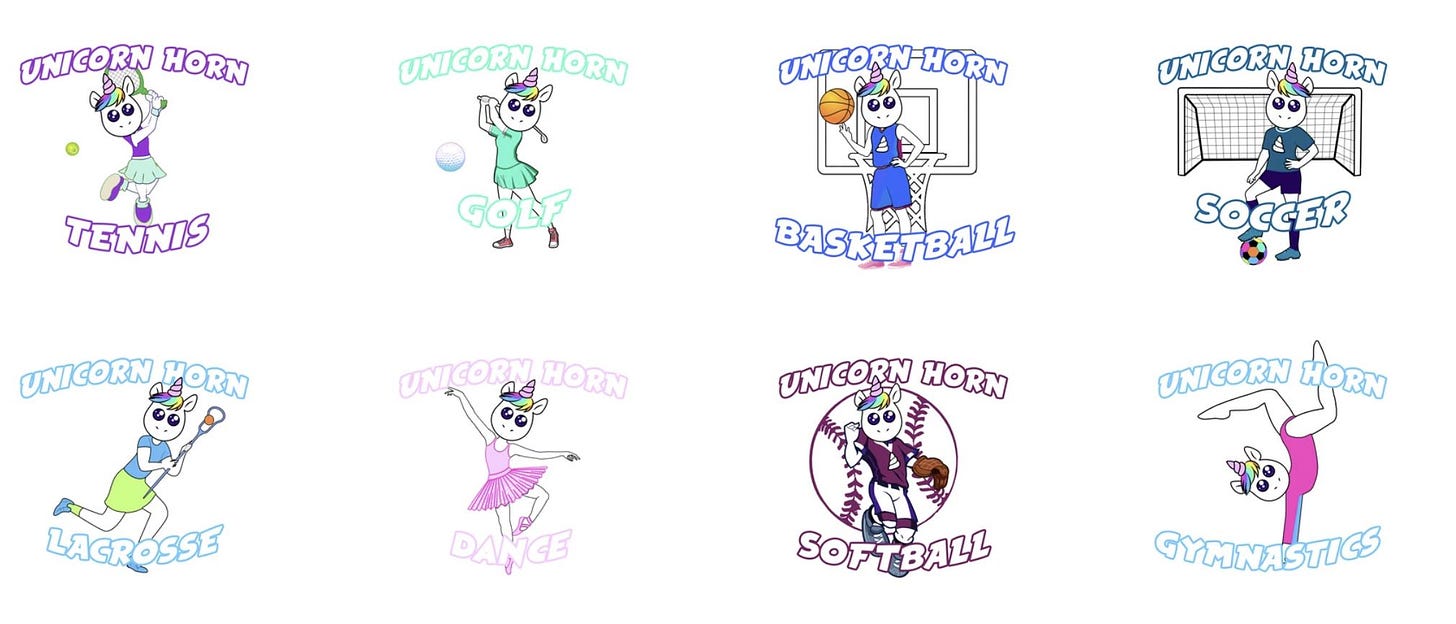PPPPromoting a Small Business - Four P's Episode 158
Ecommerce Entrepreneurialism, Making Change, Improving Meetings, & Death of Congress.
Do you have CAPTCHA anxiety? Not just a fear that you're going to mess up and miss a box or letter when proving you're not a robot, but REAL anxiety. Like somehow the direction to "Click all of the boxes with school buses" is a test of your intelligence you can't possibly win? It's okay. It happens to all of us.
The fact that CAPTCHA is the best system we can come up with for identity security and privacy protection for logging in to websites is kind of sad. Or maybe I'm just overthinking it. After all, I do feel like my brain's neurochemistry has changed drastically since I've made the final transition from lactose-free skim cow milk to 100% almond milk. At least you won’t need to log in to read this week’s list of Four P’s.:
Unicorn Horn Magic and Ecommerce
How to Change
Improving Our Meeting Culture
The End of Collaboration
Something Personal: Unicorn Horn Magic
Several weeks ago, while watching my daughter play, I found myself in awe of her creativity and innovation. She had imagined up an entire concept around the magical powers of unicorn horns, and how they give girls like her confidence to try new things and excel. Like a lucky rabbit's foot or some other talisman, she even made a "prototype" horn out of Play-Doh. She was enthralled with the idea, and what made it even more for me was the way she pronounced "Unicorn Horn," with an accent that combined elements of Long Island, Staten Island and Old English. Which naturally turned into this sing-like jingle that our family could not stop singing.
Anyone who has been around a 7 year-old girl knows just how important unicorns can be in their lives: clothing, toys, books, movies, you name it. Sydney and I have spent a lot of time talking about what the Unicorn Horn means to her... and what it could mean to others: girls, boys, non-conformers, even grown-ups. Another idea that quickly emerged was the idea of a unicorn horn as somewhat of a sports mascot, not for any team, but more of a generic inspiration. And thus, her idea of Unicorn Horn Sports was born. Creating physical things that could empower, inspire, build confidence came next, in the form of fun, colorful t-shirts for various sports and activities. We got started with some initial designs and samples, and Sydney's dream of creating an online store to sell her Unicorn Horn t-shirts is now consuming our family.
Fortunately, her dad has some digital marketing and media experience... but unfortunately, no real knowledge of how to set up and run an ecommerce business. From merchandise/supply and inventory to the transactional management, itself, we're learning this together. Seeing her excitement as this idea comes to life has been incredible. I spent most of Saturday creating a Shopify account, which I'd heard and learned so much about, but never actually experienced first-hand until now. It's actually quite simple, and while the fees are high, most of the work is done and we're ready to roll. As we learn about building a small business together, now is the time to tap into some of the marketing knowledge I've accrued over the decades🙂 Of course, I had the Instagram and Twitter accounts live before we even had the store.
Yes, Sydney actually helped me to design the whole line, with over a dozen #UnicornHorn sports t-shirts ready for purchase. Available in youth and adult sizes, as well as a variety of colors & sports, we've also launched this just in time for June. And while a get-rich-quick payout would be great, that's not what we're in this for. Instead, a percentage of all sales will go to support The Trevor Project during #Pride throughout June. 🦄🌈⚽️🥎🎾⛳️🏸🤸♀️🥍🏳️🌈
Something Practical: How to Change
Several years ago, I was introduced to a wonderful professional management coach, both as part of group training and individual sessions sponsored by my company. We've kept in touch ever since and I have always cherished, valued, and revisited his lessons. One such idea around personal development has been about change, itself. If you want to change your life and achieve your goals, the first step is actually addressing them objectively, even acknowledging mistakes or any shortcoming and failings one by one.
Our ability to change is part of life, as are the obstacles to change, such as procrastination, fear, laziness and impulsiveness. Whether you tackle your laziness, your impulsivity, or your bad habits first, make sure you take a tailored approach. That's what I learned - how to make use of frameworks and tools such as commitment devices, habit formation, social influences, and temptation bundling.
A good place to start after setting goals or committing to change is to talk about them with others. People do this with New Year's resolutions because a fresh start can make it easier to change. It can also apply after any kind of milestone or new start – like a birthday, the start of a new semester, or the Monday of any run-of-the-mill week. It changes our perspective. It puts distance between the past, those failed attempts or mistakes. But we must also avoid the pitfalls and roadblocks along the way:
Impulsivity, also known as present bias, is one such pitfall. When you act impulsively, you prioritize instant gratification over larger, long-term goals. One way to beat it is a tactic called temptation bundling. It’s a way of pairing a pleasurable activity with a demanding but worthwhile task in order to make the work seem more appealing. In other situations, gamification might be a better answer to impulsivity: adding game-like elements, such as leaderboards, points, and rewards.
Procrastination is another pitfall. The problem with procrastination is that it often compounds, and creates a hole too big to overcome. But commitment devices can help here. These are systems designed to restrict freedom in order to limit temptations. It could be a financial fine/penalty, or even just a public pledge. Writing this newsletter and making videos is somewhat of a public pledge. I said I'm going to do them, and I keep doing them. Public pledges are less costly, but they’re still surprisingly effective. By making your aims known to your friends and family, you create a powerful incentive to keep working hard.
Laziness is another vice to which so many of us can occasionally (or more often) fall prey. Human nature is to take the easy way out when facing obstacles. Habits and routines are the cure to laziness. Neuroscientists have shown that the more ingrained a habit becomes, the less we rely on the parts of our brain involved in reasoning or questioning.
Crises of confidence can be barriers to change, as well. My preferred way to overcome these, ironically enough, is to give other people advice. Humans like to help each other. When we notice someone struggling, we try to lend a hand – and, very often, our assistance takes the form of advice. We offer tips on parenting and dieting, on making friends and finding a partner. Offering people solicited guidance will, paradoxically, boost your confidence in your own abilities.
Ultimately, surrounding yourself with good, caring people is critical for change. They say it takes a village, but learning from, and with others is the best way to change. If you’ve got the right friends aligned with the broader "social contract," it can also change you for the better.
Something Professional: Improving our Meeting Culture
Around this time last week, I found myself a part of a Zoom meeting with at least 16 other people. This wasn't one of those company-wide, all-hands meetings, but was just a regular, weekly work session between client and agency teams. The troubling part was that there were 14 people from my company and only two people representing the client team. Not the best ratio, and no one's fault, really. New projects and concurrent workstreams have expanded in great ways over the last few months, and we are now working across 8 or 9 capabilities collaborating on a truly omni-channel marketing relationship. But there were far more people taking part than necessary. And the client noticed.
It will now be the last weekly status meeting with this group that I attend, and the same goes for half of last week's attendees. We just don't all need to be there. Had we not been working in this new perma-remote professional landscape, who knows how things would have evolved. But now more than ever, virtual communication needs to be planned, organized and optimized. We seemingly have more internal meetings, more informal check-ins, and more client meetings than ever before. Without in-person opportunities to connect, planned meetings have taken over.
A glance at my scary calendar (my daughter calls it "a sea of red") in any given week could include weekly capability leadership meetings, geographical capability leadership meetings, client-specific internal team meetings, cultural planning meetings, operational planning meetings, performance reporting recaps, "all-hands" meetings by country and all-company, monthly finance meetings, quarterly business meetings, weekly action reviews, and of course, every possible combination of 1:1 meetings (weekly or biweekly) between team leaders and relevant staff members.
Anyone who’s ever worked, well, anywhere, knows just how challenging some meetings can be. They can interrupt work flow, and often feel like a long-winded rehashing of information you’re already familiar with. Unfortunately, many leaders don’t know how to use them effectively. A previous CEO with whom I once worked would occasionally stroll the office and count the number of people in a meeting, then send the team lead a calculation of the cost of the meeting based on hourly rates. With executives, it would be in the thousands of dollars. Overall, on a yearly basis, meetings can cost companies hundreds of thousands of dollars.
But not always. Meetings are also essential to a smooth-running company. It is important not to overlook the positive effects that meetings can have, such as creating alignment and boosting employee morale. Holding regularly scheduled meetings is still the best way to communicate and get everyone on the same page. But that’s not all – meetings can also improve employee skill sets, strengthen teams and help build the very foundation of your company’s values and goals. Meeting efficiency is both an art and science.
First, make sure the meeting starts on time, which means getting people to arrive before the scheduled start time. Being timely is a sign of respect, and being tardy clearly signals disrespect, both of the company and of their coworkers. Another solution is to create a culture of opting out. People often get called to a meeting even though they have no real business being there. So why not share the agenda a few days in advance and allow people to opt out of attending if there’s no business relevant to them being discussed. And advanced agendas should be required. People can arrive for, and depart after, their relevant segments.
Any meeting brings with it the chance for team members and staff to flex different professional muscles. I like to assign a few roles, such as moderator, whose job it is to make sure everyone sticks to the agenda, and give key people the opportunity to present. You don’t need to have the typical leaders run the show. You can also use meetings to bring quiet personalities out of their shell.
The most difficult times of the day for employees are the mid-day dips between 11 a.m. and 2 p.m., when energy levels are often at their lowest. This makes them the perfect time to hold team meetings designed to raise morale and make sure employees know that their work is appreciated. It also gives time before and after to get work done individually.
There’s no avoiding the fact that things change, but meeting are still all about communication. Email and Slack are often no better, increasingly out of control, as well. Due to the pandemic and increased globalized workforce (especially true at my company), virtual or online meetings have even become a step up from the traditional meeting. We must remember that we now speak differently than before. If people can’t see you, it’s important to pause between sentences every once in awhile, so that people can chime in with a response. It’s also wise to provide vocal and visual gestures to let others know that you are engaged in the discussion. A simple “mm-hmm” will reassure the speaker that their message is getting across.
By bringing together leadership and team members, meetings are the best way to make sure everyone is on the same page in regards to their goals and how well they’re moving toward them.
Something Political: The End of Collaboration
Just when you thought things couldn't get any lower or embarrassingly fucked in Congress, we're reached a new nadir in terms of expectations, leadership, civility and partisanship. Until last week, I retained some small iota of hope that there would be at least a few issues on which most elected officials could agree. But that ended when they failed to unilaterally support an investigation into the armed attack on the Capitol, a riot that resulted in the death of police officers and mob violence that breached the floors of the House of Representatives and the Senate. How 60 Senators could not support an investigation - not even passing a law - is beyond embarrassing.
So that's it. Congress is done. It's over. There's no coming back from this. We're not talking about socially or economically controversial issues here. And it's hard to envision where there can, or will, be common ground ever again now.
The actual story goes like this: Last week, Republicans in the Senate killed a bill to establish a bipartisan, independent committee to investigate the January 6 insurrection. The vote was 54 to 35, and yet the thirty-five “no” votes won because of the Senate filibuster rule, which requires 60 votes to break, even if the minority doesn’t show up to vote.
Democratic leadership can still appoint and create a commission, but without bipartisan support, it will be assailable. I've gotten what seems like a dozen or more emails from Nancy Pelosi this past week, who is clearly irate. She clearly preferred the bipartisan approach, but it is clear that Republicans feared some of their own would be implicated
As a student of history, I cannot think of a more overt, single-day attack on our democracy in our history. But representative leaders like Florida's Matt Gaetz and Georgia's Marjorie Taylor Greene resort back to the original “Big Lie” that led to the insurrection in the first place. Both have directly referenced the Second Amendment to talk about armed rebellion against the government. President Biden continues to focus on economic and social issues across the country, from COVID recovery to job creation. But it's hard to imagine any real measurable progress with obstructionists constantly standing in the way. His 63% job approval rating should be substantial enough to push an agenda of progress, but we'll see.
Last week, he proposed a $6 trillion budget, tying together three plans he’s already proposed—the $2.3 trillion American Jobs Plan, the $1.8 trillion American Families Plan, and $1.5 trillion in discretionary spending for education, health, science, and infrastructure. The goal is to rebuild the middle class and make America globally competitive again. Unfortunately, Republicans have vowed to oppose all tax increases and want no part of Biden’s proposed spending. Looks and sounds like more of the same, which will result in more of the same... inequality, suffering and moral decay.
Happy start to the summer, everyone!














Hi Matt, just wanted to say how much I have been enjoying your writing. Keep up the good work!